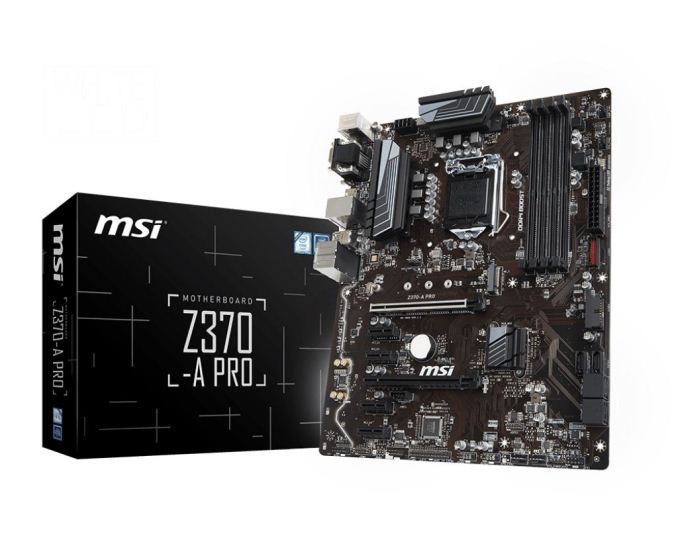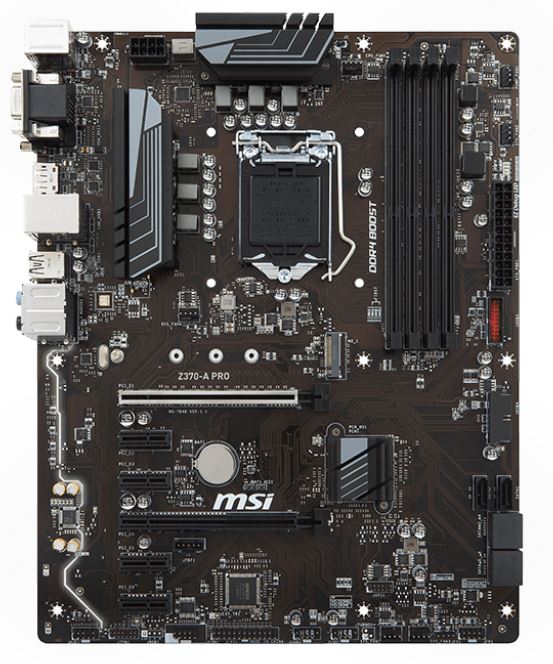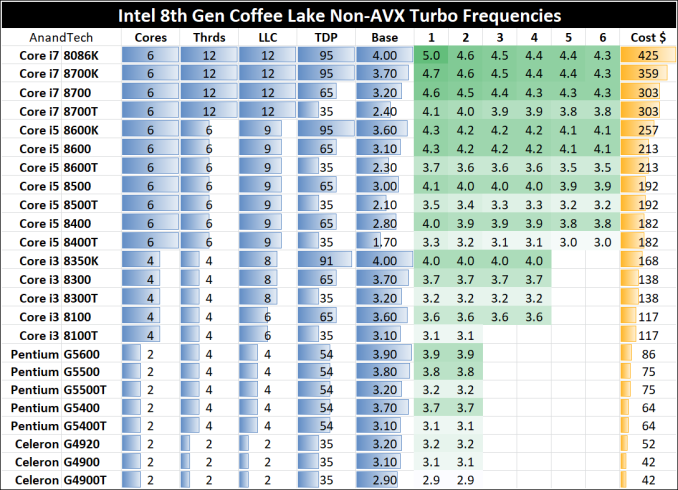The MSI Z370-A Pro Motherboard Review: Entry Level Business (And Pleasure)
by Joe Shields on September 11, 2018 8:00 AM EST- Posted in
- Motherboards
- MSI
- Coffee Lake
- Z370
- i7-8700K
- Z370A-Pro
- Pro Series

The MSI Z370-A Pro is an inexpensive motherboard from MSI's 'Pro' series of boards. The Pro series boards are designed for content creators and professionals who can use the horsepower of the high-end Coffee-Lake CPUs and require reliability and performance. The Z370-A Pro, at $110, in this review strives to accomplish fitting in here with its complement of features, as well as supporting overclocking to get the most out of the installed processor.
MSI Z370-A Pro Overview
The Z370-A Pro comes from a family of 13 different motherboards in MSI's Z370 lineup. Within that lineup are boards from its various categories from Enthusiast Gaming, Performance Gaming, and Arsenal Gaming, and the Pro series, all designed to offer users different feature sets and aesthetics. The Z370-A Pro is the cheapest of the line up, and is not intended to be an RGB light show and meant to impress with flare and substance, but meant for business users who want or need high performance and use the latest Intel Coffee Lake processors like the i7-8700K and do not want to pay more than needed for features that may not be used.
We inferred the board wouldn't win any beauty contests with its plain black/dark brown theme, but it isn't intended to either. Fancy heatsinks and RGB LEDs do add to the cost of the board which are features that are not likely to be on the top of the list for professional users. Typically they are looking for a reliable system which is able to get the job done and quickly, without breaking the budget.
AnandTech Intel Z370 Motherboard and CPU Coverage
- The Anandtech Coffee Lake Review: Initial Numbers on the Core i7-8700K and Core i5-8400
- Analyzing Z370 for Intel's 8th Generation Coffee Lake: A Quick Look at 50+ Motherboards
- The Intel Core i7-8086K Review
In our performance testing, the MSI Z370-A Pro performed well overall with results being competitive. Highlights include the power consumption, which was on the lighter side for both idle and load testing, and the board hasa pretty quick boot time. Other results were on par with other datasets so there is nothing holding the board back for our testing.
For overclocking, the $110 motherboard was able to reach 5.1 GHz. As is the case with overclocking this CPU, we are limited by the cooling and not the motherboard. The OC Genie 4 one-touch button raised both the all core CPU speed by 100 MHz, and the single core speed by 100 MHz as well, yielding 4.4 GHz and 4.8 GHz clocks. The voltage used was higher than needed for the clocks, but it did not surpass our cooling capabilities which we have seen in the past from almost all boards.
On the storage side of things, the MSI Z370-A Pro gives users the full complement of six SATA ports and has one M.2 slot for high-speed storage. Network duties are handled by a single Realtek LAN controller - Wi-Fi is not available. For USB connectivity, there are a total of six ports on the back (four USB 3.0 and two USB 2.0) along with internal headers for a total of 14 possible USB ports (eight USB 3.0 and six USB 2.0). Missing is USB 3.1 support which if needed will have to come from an add-in card.
The board includes a total of six PCIe slots, two full-length, and four x1 size slots. The first full-length slot is CPU connected while the second (and x1 slots) are fed from the PCH. The board is able to support Crossfire only with MSI saying in their literature the Pro series boards are optimized by phyiscal layout and power design for cryptocurrency mining including additional BIOS options said to ensure a stable system for long mining sessions.
The rear IO consists of three video outputs (VGA, DVI-D, and a full size DisplayPort) a PS/2 mouse/keyboard combo port, four USB 3.0 ports, Two USB 2.0 ports, the LAN port, and 6-plug audio stack.
| MSI's Z370 Motherboard Lineup | ||
| Amazon | Newegg | |
| Z370 Godlike Gaming | - | - |
| Z370 Gaming Pro Carbon AC | $199 | $210 |
| Z370 Gaming Pro Carbon | - | $180 |
| Z370 Gaming M5 | $180 | $170 |
| Z370 Krait Gaming | $157 | $157 |
| Z370I Gaming Pro Carbon AC | $167 | $170 |
| Z370M Gaming Pro AC | $165 | $165 |
| Z370 PC Pro | $128 | $136 |
| Z370 Tomahawk | $138 | $130 |
| Z370 SLI Plus | $136 | $130 |
| Z370M Mortar | $134 | $124 |
| Z370-A Pro | $112 | $118 |
| Z370 Gaming Plus | $110 | $130 |
^ - 3rd party seller
*It should be noted that from this point on in our Z370 motherboard reviews, we are using Windows 10 RS3 with the Spectre/Meltdown patches as well as other script adjustments.
Information on Intel's Coffee-Lake CPU Desktop Processors
One important piece of information to note: technically these processors use the LGA1151 socket, also used by 6th and 7th Generation processors using the Z170 and Z270 chipsets. But due to several (albeit minor) difference in the pin-layout of these two sets of processors, the 8th Generation Coffee Lake will only work in Z370 boards and are not cross-compatible. Back in October 2017, Ian Cutress reviewed a couple of processors (i7-8700K and i5-8400) in the Coffee Lake lineup - details on the rest of the product stack are listed below.
The MSI Z370-A Pro Review
In this review, we have the following pages:
- Overview
- Visual Inspection
- BIOS and Software
- Board Features
- System Performance
- CPU Performance
- Gaming Performance
- Overclocking Performance
- Conclusions














12 Comments
View All Comments
PeachNCream - Tuesday, September 11, 2018 - link
Visual Inspection, 1st Paragraph - "Off the bat, users should be how MSI makes up the basics on a $110 motherboard:"That line needs help.
halcyon - Tuesday, September 11, 2018 - link
Really entry level indeed. My MSi Z370 Pro crapped at ~175W load, even with extra VRM cooling. Upgraded to more expensive Asrock Taichi Z370 and OC is so much more stable at higher loads.imaheadcase - Tuesday, September 11, 2018 - link
That doesn't sound like the motherboard at all.qlum - Tuesday, September 11, 2018 - link
about the vrm's being sufficient for overclocking while the system may not downright crash or throttle with your load does not mean they are sufficient to sustain such overclock for a user.the vrm may run very hot, enough so to seriously impect the lifespan of the components. the 'heatsinks' are not that great at dissipating the heat but have enough mass to keep the vrm cool enough for some time until it does overheat. often cases do not provide a lot of airflow over the vrm resulting in higher temperatures. Some workloads like blender can be very stressfull over a longer peroid of time
So basically just because it keeps running the overclock in your test does not really mean the motherboard is able to sustain such overclock for daily use.
timecop1818 - Tuesday, September 11, 2018 - link
daily use overclocking is fucking retarded anyway. the stuff is fast enough, if you want it faster buy something that will be faster, no need to run stuff out of spec.PeachNCream - Tuesday, September 11, 2018 - link
So much of this! Overclocking is interesting, maybe a learning experience, but of little practical use and doing so results in unnecessary expenses from a cascade of additional problems that must be mitigated with components that would otherwise never have been needed to begin with. It creates perceptions like these about VRM cooling or about the necessity of 1KW power supplies. Have fun with it, but if you're working on some sort of task that you can't afford to lose or redo, then don't overclock your computer.Death666Angel - Tuesday, September 11, 2018 - link
So where can I buy a 5.2GHz Intel CPU then? Apart from the fun of maxing out component, you can attain results with overclocking, that you can't buy "in spec" from Intel or AMD.mischlep - Tuesday, September 11, 2018 - link
"The rear IO consists of three video outputs (VGA, DVI-D, and HDMI) "This motherboard has Displayport, not HDMI.
Ryan Smith - Tuesday, September 11, 2018 - link
Thanks!gobaers - Tuesday, September 11, 2018 - link
I would posit that the blain black/brown scheme is exactly why this *would* win a beauty contest. I'm not a 11yo seeking flashing lights, I find most high end component design to be garish and off-putting.